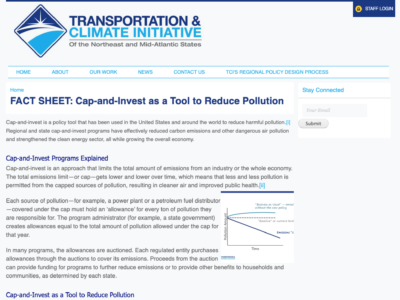
Cap-and-invest is an approach that limits the total amount of emissions from an industry or the whole economy. The total emissions limit—or cap—gets lower and lower over time, which means that less and less pollution is permitted from the capped sources of pollution, resulting in cleaner air and improved public health.[ii] A line graph showing that under a cap-and-invest policy, pollution declines over time relative to a business as usual scenario
Each source of pollution—for example, a power plant or a petroleum fuel distributor—covered under the cap must hold an ‘allowance’ for every ton of pollution they are responsible for. The program administrator (for example, a state government) creates allowances equal to the total amount of pollution allowed under the cap for that year.
In many programs, the allowances are auctioned. Each regulated entity purchases allowances through the auctions to cover its emissions. Proceeds from the auction can provide funding for programs to further reduce emissions or to provide other benefits to households and communities, as determined by each state.

